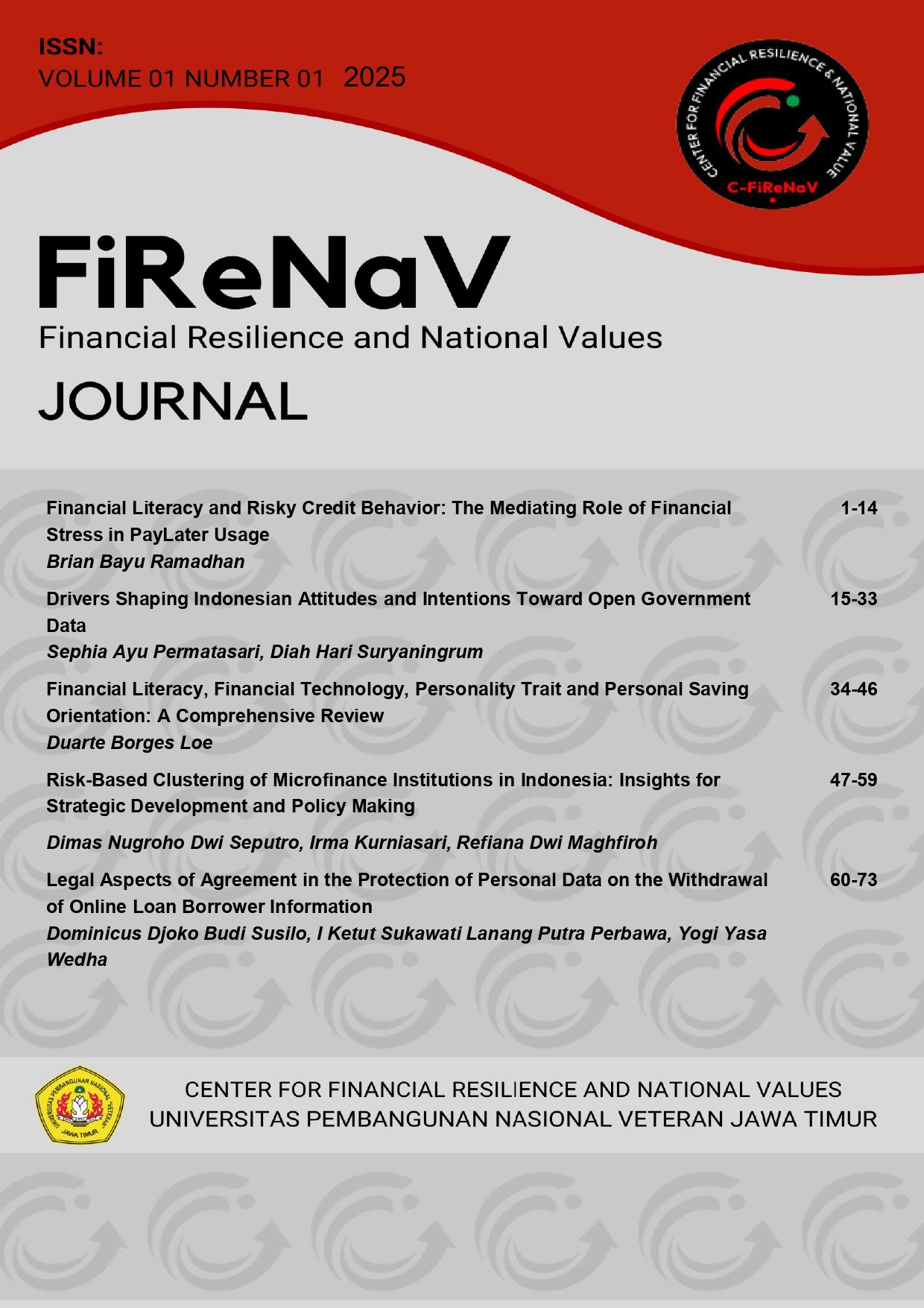Financial Literacy, Financial Technology, Personality Trait and Personal Saving Orientation: A Comprehensive Review
Keywords:
financial literacy, FinTech, financial education, saving behavior, economic behaviorAbstract
Purpose: Education, knowledge, and awareness, known as financial literacy, financial technology (FinTech), and personal saving orientation are essential agenda in the economic discourse. This review aims at integrating current literature on these themes with the view of analyzing their connections and relevance on economic behavior.
Method: A combination of sources is evaluated in the course of the study, using literature review procedures; the research seeks to establish how financial education, technological advancement, and personal perspectives on saving are connected.
Findings: The analysis reveals a positive correlation between financial literacy and saving orientation, mediated by financial attitudes and education. Unexpectedly, some studies highlight a digital divide, where access to FinTech varies based on socioeconomic status, potentially exacerbating financial inequalities. Some implications for further research are presented, which reflect the directions that the authors found to be understudied in contemporary literature.
Novelty: This study extends financial education and financial knowledge idea by defining the financial literacy as knowledge, which allows applying the financial information to the benefit of the person to make a decision. This not only expands but also improves the evaluation of the society’s financial literacy by providing a broader approach of how knowledge is leveraged into managing an individual’s financial resources and the decisions affecting his or her future well-being.
References
Adegoke, T. I., Ofodile, O. C., Ochuba, N. A., & Akinrinola, O. (2024). Data analytics in finance and mortgage: A catalyst for addressing inequities faced by under-reserved populations in the USA.
Agus Eko Sujianto, Jani, & Timbul. (2024). Correlation of financial literacy with saving. World Journal of Advanced Research and Reviews, 22(2), 215–221. https://doi.org/10.30574/wjarr.2024.22.2.1338
Amagir, A., Groot, W., Maassen van den Brink, H., & Wilschut, A. (2018). A review of financial-literacy education programs for children and adolescents. Citizenship, Social and Economic Education, 17(1), 56–80. https://doi.org/10.1177/2047173417719555
Amnas, M. B., Selvam, M., & Parayitam, S. (2024). FinTech and Financial Inclusion: Exploring the Mediating Role of Digital Financial Literacy and the Moderating Influence of Perceived Regulatory Support. Journal of Risk and Financial Management, 17(3). https://doi.org/10.3390/jrfm17030108
Ang, K. G. (2024). The Study of the Impact of Financial Goal Setting on Personal Investment Performance. SSRN Electronic Journal, June. https://doi.org/10.2139/ssrn.4844639
Arif, I., Khan, L., & Irshad, N. (2024). Does Time Matter? Impact of Financial Decision-making Abilities on Financial Choices Mediated By Time Perspective. Serbian Journal of Management, 19(1), 117–131. https://doi.org/10.5937/sjm19-44038
Atkinson, A., & Messy, F.-A. (2012). Measuring financial literacy: results of the OECD infe pilot study. OECD Working Papers on Finance, Insurance and Private Pensions, 15(15), 1–73.
Augustin, L. A. V, & Martin, T. K. (2022). Financial literacy and the level of financial planning individuals use. Financial Services Review. https://search.ebscohost.com/login.aspx?direct=true&profile=ehost&scope=site&authtype=crawler&jrnl=10570810&AN=163770548&h=HHJDCPfqV0aBVP9EiFCkltyLXYdtNLsTIjPu4HCxvoG%2BDmCEvwGAs2%2BSJFX6uxZtkjWI36uw3Qe3jPXNsiHZ%2Fw%3D%3D&crl=c
Azlan, A., Jamal, A., Kamal, W., Mohdrahimie, R., Roslemohidin, A. K., & Osman, Z. (2015). The Effects of Social Influence and Financial Literacy on Savings Behavior: A Study on Students of Higher Learning Institutions in Kota Kinabalu, Sabah. International Journal of Business and Social Science, 6(111), 110–119.
Banthia, D., Dey, S. K., Rindivenessia, A., Fikri, muhammad ali, Rahmanita, N. D., Kusnendi, K., Utami, S. A., Yanto, H., Ismail, N., Kiswanto, K., Rahim, N. M., Baroroh, N., Lavrinenko, O., Čižo, E., Ignatjeva, S., Danileviča, A., Krukowski, K., Goulart, M. A. de O. V., da Costa, N. C. A., … Waring, J. (2022). Pengaruh Locus of Control, Perencanaan dan Literasi Keuangan terhadap Perilaku Keuangan UMKM. International Journal of Bank Marketing, 8(1), 51–60. https://doi.org/10.1177/2319714519826651
Basdekis, C., Christopoulos, A., Katsampoxakis, I., & Vlachou, A. (2022). FinTech’s rapid growth and its effect on the banking sector. Journal of Banking and Financial Technology, 6(2), 159–176. https://doi.org/10.1007/s42786-022-00045-w
Beck, T., Demirgüç-Kunt, A., & Honohan, P. (2009). Access to financial services: Measurement, impact, and policies. World Bank Research Observer, 24(1), 119–145. https://doi.org/10.1093/wbro/lkn008
Bhargava, M., Sharma, A., Mohanty, B., & Lahiri, M. M. (2022). Moderating Role of Personality in Relationship to Financial Attitude, Financial Behaviour, Financial Knowledge and Financial Capability. International Journal of Sustainable Development and Planning, 17(6), 1997–2006. https://doi.org/10.18280/ijsdp.170635
Brooks, C., & Williams, L. (2021). The impact of personality traits on attitude to financial risk. Research in International Business and Finance, 58(July). https://doi.org/10.1016/j.ribaf.2021.101501
Campbell, W. K., Exley, J., & Doyle, P. C. (2023). The Big Five Personality Traits (OCEAN) and Financial Planning: A Narrative Review and Recommendations for Advisors. Financial Services Review, 31(4), 31.
Che Hassan, N., Abdul-Rahman, A., Mohd Amin, S. I., & Ab Hamid, S. N. (2023). Investment Intention and Decision Making: A Systematic Literature Review and Future Research Agenda. Sustainability (Switzerland), 15(5), 1–22. https://doi.org/10.3390/su15053949
Cho, T. Y., & Chen, Y. S. (2021). The impact of financial technology on China’s banking industry: An application of the metafrontier cost Malmquist productivity index. The North American Journal of Economics and Finance. https://www.sciencedirect.com/science/article/pii/S1062940821000486
Christianto, J. A., & Asandimitra, N. (2023). Analysis of Factors Influencing Saving Behavior among the Millennial Generation in Surabaya with Saving Intention as a Mediating Variable. International Journal of Academic Research in Business and Social Sciences, 13(11), 495–509. https://doi.org/10.6007/ijarbss/v13-i11/19286
Darnida, Y. C., Haryono, A., & Nurriqli, A. (2024). The Role of Financial Technology in Increasing Financial Access. 3(2), 474–493.
Dem, L., Enst, M., & Anab, L. (2002). F i̇ nansal planlamada öngörü metodu olarak rasyolarin kullanilmasi ve tekst i̇ l sektörü i̇ş letmeler i̇ nde b i̇ r uygulama. September.
Denkers, A., Uhl, F. ., De Jager, L. ., Nijkamp, R., & Vlaming, D. (2024). A behaviour-based look at money matters Insights from experience & from science. April.
Despard, M., Roll, S., Grinstein-Weiss, M., Hardy, B., & Oliphant, J. (2023). Can behavioral nudges and incentives help lower-income households build emergency savings with tax refunds? Evidence from field and survey experiments. Journal of Consumer Affairs, 57(1), 245–263. https://doi.org/10.1111/joca.12498
Ding, H., Yu, E., & Li, Y. (2020). Strengths-based leadership and its impact on task performance: A preliminary study. South African Journal of Business Management, 51(1), 1–9. https://doi.org/10.4102/sajbm.v51i1.1832
Disney, R., Gathergood, J., & Weber, J. (2015). Credit counseling: A substitute for consumer financial literacy? Journal of Pension Economics and Finance, 14(4), 466–491. https://doi.org/10.1017/S1474747215000219
Doda, S., & Fortuzi, S. (2015). The Impact of Saving in Personal Finance. European Journal of Economics and Business Studies, 2(1), 108. https://doi.org/10.26417/ejes.v2i1.p108-112
Duchek, S., Raetze, S., & Scheuch, I. (2020). The role of diversity in organizational resilience: a theoretical framework. Business Research, 13(2), 387–423. https://doi.org/10.1007/s40685-019-0084-8
Fauzi, A., Fauziah, N. T., & Rahayu, S. (2024). The Psychology of Saving: How Mindset Impacts Financial Competence. Coopetition: Jurnal Ilmiah Manajemen, 15(2), 367–376. https://doi.org/10.32670/coopetition.v15i2.4455
Frank, D., Singh, R. R., & G, V. B. (2023). Relevance of Employee Saving Attitude Towards Retirement Planning and Satisfaction. International Journal of Professional Business Review, 8(5), e01290. https://doi.org/10.26668/businessreview/2023.v8i5.1290
Friedline, T., Naraharisetti, S., & Weaver, A. (2020). Digital Redlining: Poor Rural Communities’ Access to Fintech and Implications for Financial Inclusion. Journal of Poverty, 24(5–6), 517–541. https://doi.org/10.1080/10875549.2019.1695162
García-Santillán, A. (2023). Between Income, Savings and Investment, How Do College Students Perceive Money Management? European Journal of Contemporary Education, 12(3), 849–861. https://doi.org/10.13187/ejced.2023.3.849
Governance, J. O. F. (2024). Examining Factors of Savings Behaviour Among Malaysian Youth. Journal of Governance and Integrity, 7(1), 650–667.
Guan, A. K. (2024). The Study of Achieving Personal Investment Success Through Financial Goal Setting. June. https://doi.org/10.13140/RG.2.2.23835.89125
Gustina, G., Yenida, Y., & Novadilastri, N. (2022). The Influence of Financial Knowledge, Financial Skills, and Financial Attitudes on the Financial Behavior of MSME Entrepreneurs in West Sumatra. Journal of Economics, Finance and Management Studies, 05(12), 3455–3462. https://doi.org/10.47191/jefms/v5-i12-02
Hafeez, M. (2022). Effects of game-based learning in comparison to traditional learning to provide an effective learning environment—A comparative review. Contemporary Educational Researches Journal, 12(2), 89–105. https://doi.org/10.18844/cerj.v12i2.6374
Haleem, A., Javaid, M., Qadri, M. A., & Suman, R. (2022). Understanding the role of digital technologies in education: A review. Sustainable Operations and Computers, 3(May), 275–285. https://doi.org/10.1016/j.susoc.2022.05.004
Harini, B., & Subramanian, S. (2023). Influence of Big Five Personality Traits on the Investment Decisions of Investors-Empirical Approach. Atlantis Press International BV. https://doi.org/10.2991/978-94-6463-162-3_36
Harsono, I., & Suprapti, I. A. P. (2024). The Role of Fintech in Transforming Traditional Financial Services. Accounting Studies and Tax Journal (COUNT), 1(1), 81–91. https://doi.org/10.62207/gfzvtd24
Jirjahn, U., & Ottenbacher, M. (2023). Big Five personality traits and sex. Journal of Population Economics, 36(2), 549–580. https://doi.org/10.1007/s00148-022-00893-2
Judge, T. A. (2015). Situation Strength and Trait Activation on the Person-Situation Debate Revisited: Effect of Situation Strength and Trait Activation on the Validity of the Big Five Personality Traits in Predicting Job Performance. Mendoza College of. Amj, 58(4), 1149–1179.
Kaiser, T., Lusardi, A., Menkhoff, L., & Urban, C. (2022). Financial education affects financial knowledge and downstream behaviors. Journal of Financial Economics, 145(2), 255–272. https://doi.org/10.1016/j.jfineco.2021.09.022
Kang’aru, P. N., & Tirimba, I. (2018). Effect of Financial Planning Practices on the Financial Performance of Non-Profit Making Health Organizations in Kiambu County, Kenya. In International Journal of Scientific and …. researchgate.net. https://www.researchgate.net/profile/Ibrahim-Ondabu/publication/325759522_Effect_of_Financial_Planning_Practices_on_the_Financial_Performance_of_Non_Profit_Making_Health_Organizations_in_Kiambu_County_Kenya/links/63ea1e1b6425237563ad4456/Effect-of-Financi
Kasozi, J., & Makina, D. (2021). Analysis of financial literacy and its effects on financial inclusion in Uganda. International Journal of Finance & Banking Studies (2147-4486), 10(3), 67–83. https://doi.org/10.20525/ijfbs.v10i3.1294
Kohardinata, C., Suhardianto, N., & Tjahjadi, B. (2020). Peer-to-peer lending platform: From substitution to complementary for rural banks. Business: Theory and Practice, 21(2), 713–722. https://doi.org/10.3846/btp.2020.12606
Landman, M., & Mthombeni, M. (2021). Determining the potential of informal savings groups as a model for formal commitment saving devices. South African Journal of Economic and Management Sciences, 24(1), 1–12. https://doi.org/10.4102/sajems.v24i1.3940
Li, R., Wu, J., Zhang, S., Zhang, S., & Wu, Y. (2023). Social Endowment Insurance and Inequality of the Household Portfolio Choice: The Moderating Effect of Financial Literacy. SAGE Open, 13(1), 1–13. https://doi.org/10.1177/21582440231152399
Li, Y., Li, Z., Su, F., Wang, Q., & Wang, Q. (2020). Fintech Penetration, Financial Literacy, and Financial Decision-Making: Empirical Analysis Based on Tar. Complexity, 2020. https://doi.org/10.1155/2020/6696312
Liu, Q., Chan, K. C., & Chimhundu, R. (2024). Fintech research: systematic mapping, classification, and future directions. Financial Innovation, 10(1). https://doi.org/10.1186/s40854-023-00524-z
Lucky Bamidele Benjamin, Prisca Amajuoyi, & Kudirat Bukola Adeusi. (2024). Marketing, communication, banking, and Fintech: personalization in Fintech marketing, enhancing customer communication for financial inclusion. International Journal of Management & Entrepreneurship Research, 6(5), 1687–1701. https://doi.org/10.51594/ijmer.v6i5.1142
Łukasz, G., & Daw, G. (2024). Households ’ Financial Literacy in Central European Countries – a Recent Survey in Poland. https://doi.org/10.20944/preprints202406.1314.v1
Lusardi, A., & Messy, F.-A. (2023). The importance of financial literacy and its impact on financial wellbeing. Journal of Financial Literacy and Wellbeing, 1(1), 1–11. https://doi.org/10.1017/flw.2023.8
Maleh, Y., Zhang, J., & Hansali, A. (2024). Advances in Emerging Financial Technology and Digital Money. In Advances in Emerging Financial Technology and Digital Money (Issue March). https://doi.org/10.1201/9781032667478
Mehak & Dharni, K. (2022). A Study on Financial Inclusion in India and Its Relation with Financial Literacy. Journal of Economics, Management and Trade, 28(1), 49–66. https://doi.org/10.9734/jemt/2022/v28i130388
Menberu, A. W. (2024). Technology-mediated financial education in developing countries: a systematic literature review. Cogent Business & Management, 11(1). https://doi.org/10.1080/23311975.2023.2294879
Miah, A., Rahouti, M., Jagatheesaperumal, S. K., Ayyash, M., Xiong, K., Fernandez, F., & Lekena, M. (2023). Blockchain in Financial Services: Current Status, Adoption Challenges, and Future Vision. International Journal of Innovation and Technology Management, 20(8). https://doi.org/10.1142/S0219877023300045
Moenjak, T., Kongprajya, A., & Monchaitrakul, C. (2020). Fintech, Financial Literacy, and Consumer Saving and Borrowing: The Case of Thailand. In ADBI Working Paper Series (Issue 1100).
Mutlu, Ü., & Özer, G. (2021). The moderator effect of financial literacy on the relationship between locus of control and financial behavior. Kybernetes. https://doi.org/10.1108/K-01-2021-0062
Nasution, A. A., Harahap, D., & Uula, M. M. (2023). Environmental, Social, Governance (ESG) and Islamic Finance: A Review. Management and Sustainability, 1(1). https://doi.org/10.58968/ms.v1i1.285
Nurdin, H., Hasanuddin, Waskito, & Saddikin, M. (2019). Characteristics of Particleboard from Waste Nypa Fruticans Wurmb. Journal of Physics: Conference Series, 1387(1). https://doi.org/10.1088/1742-6596/1387/1/012103
OECD. (2019). PISA 2018 Assessment and Analytical Framework. In OECD Publishing.
Ong ViforJ, R., Suenaga, H., & Brierty, R. (2023). Homeownership and subjective well-being: Are the links heterogeneous across location, age and income? Urban Studies. https://doi.org/10.1177/00420980231190479
Onyia, O. P., & Tuyon, J. (2023). Disruptions, innovations and transformations in the global financial services market: the impacts of emerging cybersecurity, geopolitical and sustainability risks. Journal of Financial Services Marketing, 28(4), 627–630. https://doi.org/10.1057/s41264-023-00260-6
Pak, O., & Mahmood, M. (2015). Impact of personality on risk tolerance and investment decisions International Journal of Commerce and Management Article information: November. https://doi.org/10.1108/IJCoMA-01-2013-0002
Ramdani, R., Mawardi, I., & Sulaeman, S. (2023). Impact of Green Banking Implementation, Financial Performance, and Covid-19 Crisis on Islamic Bank Profitability in Indonesia. International Journal of Islamic Economics and Finance (IJIEF), 6(2), 225–246. https://doi.org/10.18196/ijief.v6i2.16802
Ratnawati, K., Prabandari, S. P., & Kurniasari, I. (2022). The impact of financial inclusion on national development and national financial system stability. HOLISTICA – Journal of Business and Public Administration, 13(2), 63–82. https://doi.org/10.2478/hjbpa-2022-0015
Remund, D. L. (2010). Financial literacy explicated: The case for a clearer definition in an increasingly complex economy. Journal of Consumer Affairs, 44(2), 276–295. https://doi.org/10.1111/j.1745-6606.2010.01169.x
Sadi, R., Asl, H. G., Rostami, M. R., Gholipour, A., & Gholipour, F. (2011). Behavioral Finance: The Explanation of Investors’ Personality and Perceptual Biases Effects on Financial Decisions. International Journal of Economics and Finance, 3(5), 234–241. https://doi.org/10.5539/ijef.v3n5p234
Shoham, A., & Malul, M. (2012). The role of cultural attributes in savings rates. Cross Cultural Management, 19(3), 304–314. https://doi.org/10.1108/13527601211247062
Shrestha, S. K., Manandhar, B., Bhattarai, P., & Shrestha, N. (2023). Intelligence Journal of Multidisciplinary Research Impact of Financial Literacy on Personal Investment Decisions in Kathmandu Valley. Research Management Cell, 2(1), 25–34.
Singh, S., Jaiswal, D. A., Rai, P. A. K., & Kumar, P. A. (2024). Moderating Role of Fintech Adoption on Relationship between Financial Literacy and Financial Well-being. Educational Administration: Theory and Practice, 30(4), 7597–7607. https://doi.org/10.53555/kuey.v30i4.1351
Sulistyowati, S. N., Pranoto, A. J., & Mas’adah, N. (2024). The Impact of Fintech and Financial Literacy on MSME Development through Access to Finance. DiE: Jurnal Ilmu Ekonomi dan Manajemen, 15(1), 79–87. https://doi.org/10.30996/die.v15i1.10594
Tay, L. Y., Tai, H. T., & Tan, G. S. (2022). Digital financial inclusion: A gateway to sustainable development. Heliyon, 8(6), e09766. https://doi.org/10.1016/j.heliyon.2022.e09766
Ventre, V., Martino, R., & Muñoz Torrecillas, M. J. (2024). Relationship between an inconsistent degree of financial literacy and inconsistent decision-making in intertemporal choices. Heliyon, 10(5). https://doi.org/10.1016/j.heliyon.2024.e27253
Von Collani, G., & Grumm, M. (2009). On the Dimensional Structure of Personality, Ideological Beliefs, Social Attitudes, and Personal Values. Journal of Individual Differences, 30(2), 107–119. https://doi.org/10.1027/1614-0001.30.2.107
Wann, C. R., & Burke-Smalley, L. A. (2023). Attributes of Households that Engage in Higher Levels of Family Financial Planning. Journal of Family and Economic Issues. https://doi.org/10.1007/s10834-021-09805-0
Warchlewska, A. J., Janc, A., & Iwański, R. (2021). Personal Finances in the Era of Modern Technological Solutions. Finanse i Prawo Finansowe, 1(29), 155–174. https://doi.org/10.18778/2391-6478.1.29.09
Yeo, J. H., & Fisher, P. J. (2017). Mobile financial technology and consumers’ financial capability in the United States. In Journal of Education &Social Policy. researchgate.net. https://www.researchgate.net/profile/Patti-Fisher/publication/341574984_Mobile_financial_technology_and_consumers’_financial_capability_in_the_United_States/links/640f33c0315dfb4cce78c3bd/Mobile-financial-technology-and-consumers-financial-capability-in-t
Zaini Miftach. (2018). 済無No Title No Title No Title. September, 53–54.
Zainudin, N. (2022). Factors Affecting Individual Saving Behavior: A Review of Literature. August.
Zavolokina, L., Dolata, M., & Schwabe, G. (2017). FinTech transformation: How IT-enabled innovations shape the financial sector. Lecture Notes in Business Information Processing, 276(January), 75–88. https://doi.org/10.1007/978-3-319-52764-2_6
ZL, A., C, R., & FW, S. (2019). the Influence of Parental Financial Socialisation Techniques on Student Financial Behaviour. International Journal of Economics and Finance Studies, 11(2), 72–88. https://medium.com/@arifwicaksanaa/pengertian-use-case-a7e576e1b6bf






